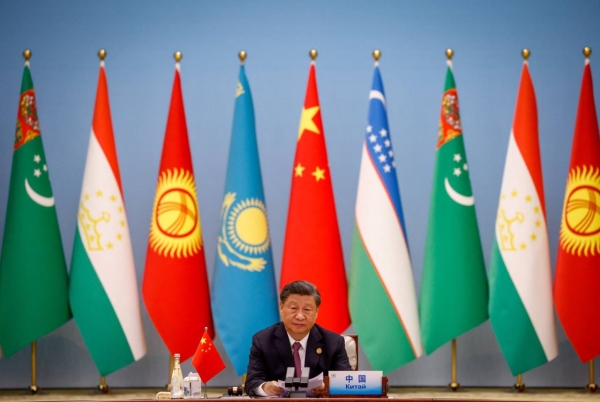The relationship between China and Central Asia is strengthening, as highlighted by U.S.-China Perception Monitor in a recent interview with Dr. Abbos Bobokhonov, a political science expert with over 15 years of experience in Central Asian affairs. Dr. Bobokhonov emphasizes that China has become an indispensable partner for all five Central Asian republics, with increasing levels of dependency on Chinese support year after year.

Dr. Abbos Bobokhonov discussed China’s strategy toward the region. China has increasingly invested diplomatic resources to enhance its presence and improve perceptions in Central Asia. This includes funding infrastructure projects and promoting its media outlets. Notably, China has adopted a unique soft power approach to win over Central Asia, as positive perceptions of the country in the region remain relatively low.
“In contemporary times, China has evolved into an indispensable partner for all five Central Asian republics. The level of dependency of the Central Asian states on China has been steadily increasing each year. Recent global events, ranging from the onset of COVID-19 to the Russian-Ukrainian crisis, have prompted China to critically reassess its role in the region,” Dr. Abbos Bobokhonov remarked.
Another critical aspect of China-Central Asian relations is the overshadowing influence of Russia. However, Russia’s war in Ukraine has distracted it from other geopolitical relationships, allowing China to fill the resulting gap. As one of the few powers supporting Russia’s actions in Ukraine, China’s growing influence goes largely unchallenged by Russia.
Dr. Bobokhonov, who holds a PhD in Political Science from the University of World Economy and Diplomacy and serves as the Head of the Indo-Pacific Studies Center at the Institute for Advanced International Studies, noted the significance of recent developments. He emphasized that China has become an indispensable partner for all five Central Asian republics, with their dependency on China increasing year by year.
According to Dr. Bobokhonov, the onset of global events, including COVID-19 and the Russian-Ukrainian crisis, prompted China to reassess its role in the region. Since Xi Jinping came to power, the introduction of the Belt and Road Initiative has marked a transformative period for China’s involvement in Central Asia. Notably, Beijing successfully institutionalized China-Central Asian relations through an inaugural summit in Xi’an in 2023, followed by the establishment of a permanent Secretariat in Xi’an in 2024.
The interview revealed that high-level visits by Chinese officials to Central Asian countries now encompass not only traditional agendas—politics, economics, investment, and humanitarian cooperation—but also focus on enhancing security, defense cooperation, and joint efforts against potential “color revolutions.”
Dr. Bobokhonov explained that this shift would have been unimaginable two decades ago, given Russia’s dominant military presence in Tajikistan and Kyrgyzstan and their membership in the Collective Security Treaty Organization (CSTO), which served as a security guarantor for Central Asian states.
He further elaborated on the changing dynamics in the region. With Russia preoccupied with the war in Ukraine, China has seized the opportunity to fully strategize its position in Central Asia. The key objectives for China include:
- Preserving Regional Position: It is essential for China to stay informed about developments in the region and align its positions with Central Asian leaders regarding bilateral relations. Mutual visits between Chinese leaders and those of Central Asian countries have become routine.
- Targeted Diplomatic Engagement: Earlier this year, four high-level Chinese officials visited Central Asian countries, with discussions in Kazakhstan focused on agricultural cooperation and in Uzbekistan addressing poverty alleviation and food security strategies. China regards importing consumer goods from neighboring Central Asia as safer and more advantageous than relying on risky maritime routes. This reliance highlights Central Asia’s potential in ensuring food security for Beijing, especially in case of disruptions in maritime trade routes.
- Infrastructure Development: China is finalizing plans for an alternative railway infrastructure connecting China directly to Kyrgyzstan, Uzbekistan, Tajikistan, and Turkmenistan. The completion of the China-Kyrgyzstan-Uzbekistan railway (CKUR) will provide China with an expedited transportation route to Central Asia and beyond, enhancing economic development between Xinjiang and the region while supporting the Belt and Road Initiative.
- Security Cooperation: Recent visits by Chinese officials, including the Minister of Defense to Kazakhstan and the Minister of Foreign Affairs to Tajikistan, aimed at discussing security and stability in the region. During these visits, concerns about recent regional instability and the risk of “Color Revolutions” were raised, underscoring China’s intention to position itself as a primary security partner in Central Asia. This is particularly important, considering China’s substantial investments—around $40bn—in the region.
Dr. Bobokhonov highlighted that security remains a fundamental focus of China’s foreign policy toward Central Asia, especially regarding the sensitive situation in Xinjiang. He pointed out that while China seeks to maintain a balance in perceptions towards itself in Central Asian countries, it also acknowledges the challenges of establishing dominance due to cultural differences and the prevailing Russian influence.
The dynamics between Uzbekistan and China are particularly noteworthy. Following a political transition in Uzbekistan in 2016, the country has pursued a nuanced policy towards China. This includes maintaining friendly relations between leaders, which has fostered intensified exchanges in governmental and other bilateral interactions.
Dr. Bobokhonov stated that China has solidified its status as Uzbekistan’s largest trade and investment partner. Between 2000 and 2022, trade turnover between Uzbekistan and China increased by 78.5 times, from $95.5mn to $7.5bn. By the end of 2023, this figure is projected to reach $14bn, although Uzbekistan is experiencing a growing trade deficit largely due to purchasing machinery, equipment, and technology from China.
Moreover, Chinese investments in Uzbekistan have steadily increased, with a total of nearly $11bn between 2017 and 2022. Currently, over 2,500 joint ventures operate in Uzbekistan with Chinese capital, highlighting the deepening economic ties.
The energy sector is also witnessing a shift, with China transitioning from an importer to an exporter of energy technologies. Since 2018, Chinese involvement in renewable energy projects in Uzbekistan has surged, aligning with Uzbekistan’s plans to develop over 20 GW of renewable energy capacities by 2030. This positions China as a key provider of energy-producing technologies, thus enhancing Uzbekistan’s energy independence amid increasing domestic gas deficits.
Dr. Bobokhonov concluded that the deepening cooperation between Uzbekistan and China, particularly in transportation and energy, underscores the strategic importance of Uzbekistan’s central location in facilitating trade routes. The recent agreements to construct the CKU railway reflect a significant step in this direction, with China holding a 51% majority share, while Uzbekistan and Kyrgyzstan each own 24.5%.




